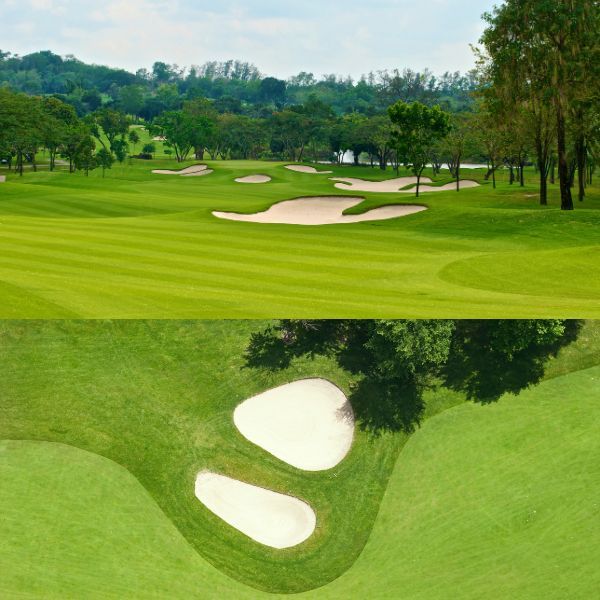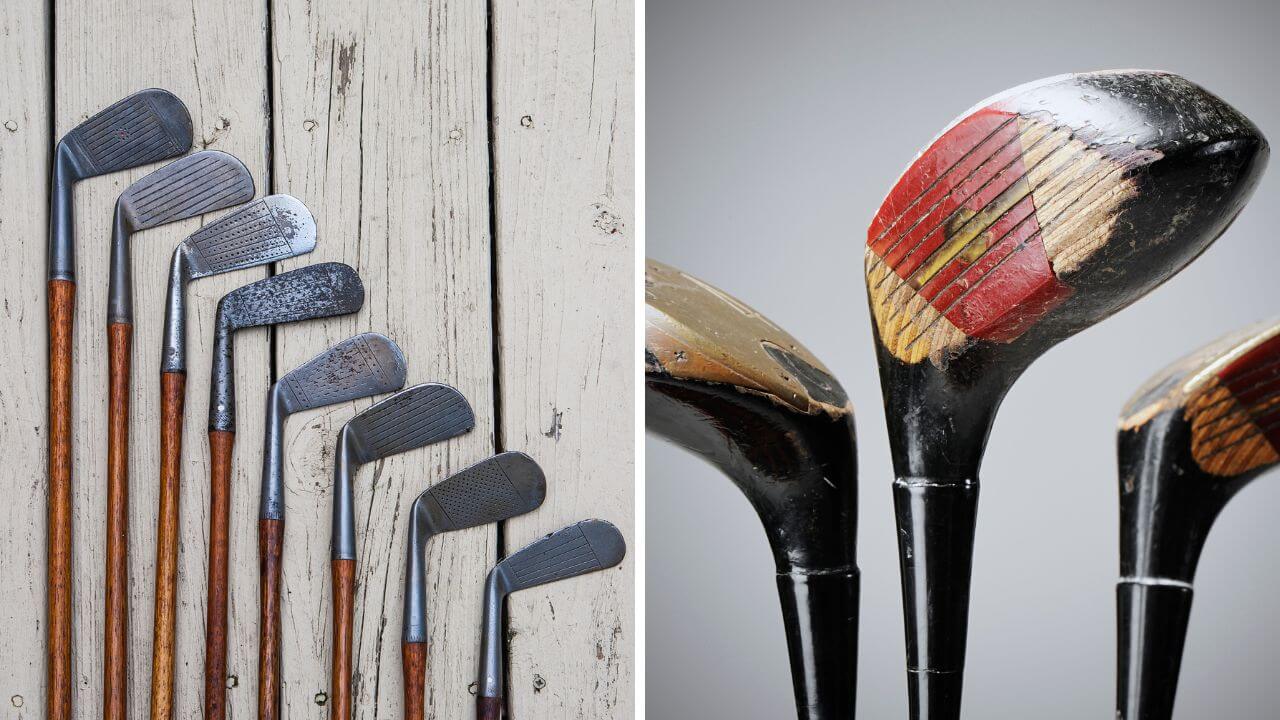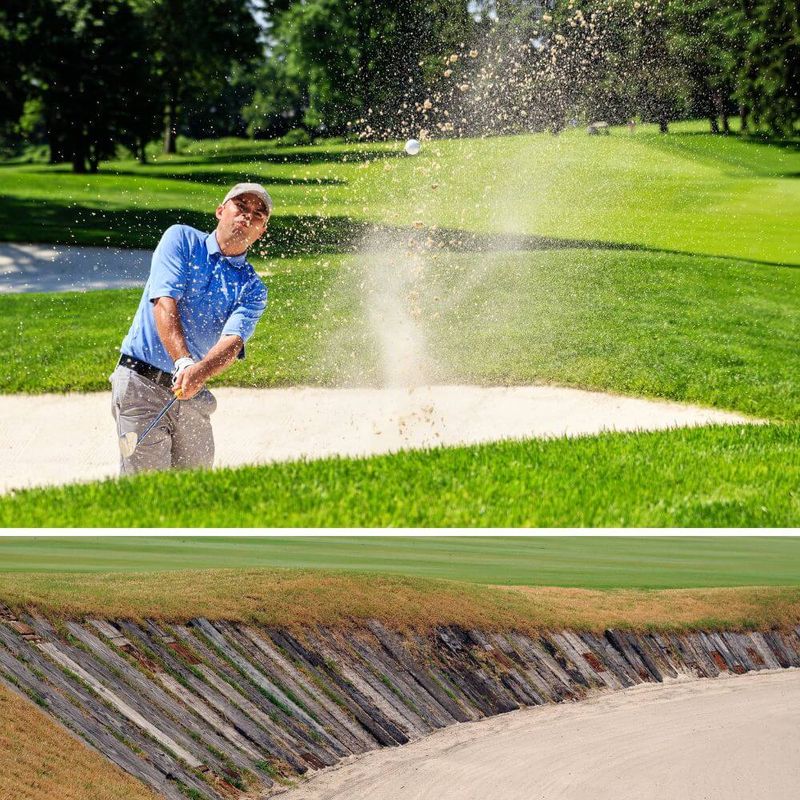Content Summary
Per the United States Golf Association:
"Bunkers are one of the five defined areas of the course. Your ball lies in a bunker when any part of it touches the sand. So that the challenge of playing from the sand is preserved, there are a few things you are not permitted to do when your ball is in a bunker. These include testing the condition of the bunker, touching the sand right around your ball, and making a practice swing that touches the sand."
Many golfers dread the sight of their ball rolling into a bunker. These treacherous sandy pits strike fear into the hearts of amateurs and pros alike. It's one of the reasons I spend a portion of every practice session hitting out of sand bunkers.
The prospect of an awkward stance in the sand coupled with the pressure of executing a precise explosion shot is enough to unravel even experienced players. Fear of heights, tight lies, short sides, and buried balls all contribute to the anxiety bunkers produce.
The consequences of hitting fat, thin, or blading a shot out of the sand often lead to a compounded penalty stroke or worse. For high handicappers, bunkers are where double and triple bogeys are born.

Simply aiming to just get the ball back out on the grass becomes the priority rather than saving par. The mental hurdle of recovering well from bunkers is just as challenging as the physical skills required. Staying composed and committed to your sand shot technique is essential for conquering the intimidation.

5 Defined Areas of a Golf Course
- The General Area
- Teeing Area
- All Penalty Areas
- All Bunkers
- The Putting Green of the Hole You Are Playing

What the Heck Is a Bunker in Golf?
A bunker is a standard feature on any golf course. It is a depression in the ground that is filled with sand or grass and is considered a hazard in the game of golf.
Bunkers are strategically placed on golf courses to add an element of challenge and complexity to the game. Players will often encounter bunkers around the greens, in the fairways, and bordering the roughs. Learning how to effectively play out of a bunker is an essential golf skill.
Bunkers are considered part of the course rather than a loose impediment like leaves or stones. So when your ball lands in a bunker, it is considered to be in play, and you must hit it out while taking care not to ground your club. Special rules apply to bunkers that do not apply elsewhere on the course.
There are several different types of bunkers, each with their own characteristics and challenges. The most common are fairway bunkers, cross bunkers, greenside bunkers, pot bunkers, and waste bunkers.
The Different Types of Bunkers
Fairway Bunker
Fairway bunkers are typically located in the fairway and designed to catch any wayward shots along the ideal line to the green. These are usually the most shallow of bunker types.
Fairway bunkers require accuracy off the tee and on approach shots to avoid. A fairway bunker shot is difficult because you have very little green to work with between the lip of the bunker and the pin. It takes finesse to splash the ball out high enough to clear the lip while still landing softly on the green.
Cross Bunker
Cross bunkers stretch horizontally across the fairway at a diagonal, perpendicular to the player's line directly toward the green.
They are meant to require precision and challenge players to carefully shape their shots around the bunker or risk catching the edge. Cross bunkers are usually very deep, so they punish players who end up in one by forcing an even more difficult shot out of the sand.
Greenside Bunker
As the name suggests, greenside bunkers border the immediate vicinity surrounding the putting green. They are designed to catch slightly mis-hit approach shots.
Greenside bunkers allow for the most creativity and variety on bunker shots, as you can utilize more loft and finesse compared to fairway bunkers. The close proximity to the pin allows players to splash the ball out and let it roll or float onto the green. However, the lips and edges of greenside bunkers can often be quite steep and overhanging.
Pot Bunker
Pot bunkers are circular sandy depressions that have very steep, vertical faces. They are notorious for swallowing up approach shots and requiring precise and powerful swings to blast the ball back out.
Pot bunkers tend to be much deeper than other bunker types, normally at least four feet. The near vertical sides provide little margin for error on explosion shots out of the sand. Pot bunkers are some of the most challenging hazards found on Scottish links-style courses.
Waste Bunker
Waste bunkers contain sandy soil but do not technically qualify as true bunkers by the rules of golf. They are usually found bordering the rough and barren areas on links-style courses. Waste bunkers are more akin to natural sandy terrain features than purposefully designed hazards.
As a result, they provide more leniency to players whose balls end up in them. You are allowed to ground your club, remove loose impediments, take practice swings, and even pick up and smooth the sand in a waste bunker without penalty.
Understanding Bunker Basic Rules
Bunkers are governed by a distinct set of rules that do not apply when you find your ball in any other type of terrain on the course. It is important for every golfer to understand these basic bunker rules:
- You are not allowed to touch or move loose impediments lying in a bunker such as leaves, stones, twigs, etc. Play the ball as it lies.
- You cannot ground your club in a bunker by touching the sand directly in front of or behind the ball during your practice swings or backswings. This results in a two-stroke penalty.
- Taking a practice swing without hitting the sand is permitted, as is incidentally touching the sand far away from your ball with a practice swing.
- No building up stances or removing the unevenness of the sand to create a flatter lie is allowed.
- You can rake tracks and footprints anywhere in the bunker except where your ball lies. Raking must be done carefully without improving your lie.
- After your shot, players must carefully re-rake areas disturbed during the shot to smooth the sand for the next player.
- You are permitted to touch or move loose impediments in a waste bunker without penalty, making it play more like the general area of the course.
Properly playing out of a bunker requires creativity, precision, and proper technique. Mastering these sand shot skills is essential for lowering your scores and avoiding huge penalties.
Brief History of Why it's Called A Bunker?
So how did these sandy hazards become known as bunkers on the golf course?
The term bunker has Scottish origins and first emerged when golf was played on the links courses of eastern Scotland in the 15th century. Early Scottish golf holes were often targets laid out on rabbit warrens, fields, and other natural terrain features. The rabbit burrows and sandy hillocks served as the original natural bunkers.

Some etymologists believe the term evolved from the Scots dialect word “bonker”, originally meaning “a blast or shot”. This referred to an explosive shot needed to get one's ball out of the sandy hollows found on links courses.
There is also a relation between bunckers and the ancient Scottish game of “bunnock” played near St. Andrews during the Middle Ages. This involved a ball being driven into sandy hollows on the links' land dunes.
The first written appearance of the term bunker about golf is from the mid-1700s in Scotland. When golf started expanding across the British Isles, the Scots name for these hazards was simply adopted.
By the late 1800s, bunkers were becoming more deliberately designed features built into courses rather than naturally occurring sandy depressions. Iconic examples were the revetted pot bunkers added to the Old Course at St Andrews.
Today bunkers are near-universal standardized features on golf courses all around the world. The purposefully designed hazards challenge pros and amateurs alike to display precision, poise, and skill under pressure.
So next time your ball ends up buried deep beneath the sand, recall the origins of these tricky tests from the rabbit warrens of Scotland centuries ago! Careful strategy and quality technique will help you conquer these craters.
Conclusion
Bunkers have become one of the most iconic features and challenging obstacles in the game of golf. These treacherous sandy pits require creativity and precision to escape from. While modern bunker design has come a long way from the rabbit warrens of 15th-century Scottish links courses, they test the resolve and true skill of all golfers who encounter them.
Whether fairway, greenside, or waste bunker, each demands strategy and mastery of the exploding sand shot to save strokes. Now when you find your ball half-buried in a tricky lie, recall the origins of the bunker from medieval Scottish dunes.
With care, calculation, and quality technique, you can escape the sands of time and conquer these craters once and for all. Keep your wits about you, follow the rules, and carve your path to lower scores.
Frequently Asked Questions - Golf Bunkers
What is a bunker in golf?
A bunker in golf is a prepared area filled with sand or other similar material. It is a type of hazard on a golf course that is designed to test the player's ability to play a ball from the sand.
What is the purpose of a bunker in golf?
The purpose of a bunker in golf is to add challenge to the game and test the player's ability to hit the ball out of difficult lies. Bunkers are strategically placed to make it more challenging for players to reach the green or make accurate shots.
Are there different types of bunkers in golf?
Yes, there are different types of bunkers in golf. The most common type is the sand bunker, also known as a sand trap. However, there are also grass bunkers and waste bunkers, each with its own unique characteristics and challenges.
What are the rules for playing a ball from a bunker?
When playing a ball from a bunker, there are specific rules to follow. According to Rule 12 of the USGA Rules of Golf, players are not allowed to touch the sand with their hands before making a stroke. The ball must be played as it lies and the player must not ground their club in the sand before making a stroke.
Can a player ground their club inside a bunker?
No, a player is not allowed to ground their club inside a bunker. According to the rules of golf, grounding the club inside a bunker before making a stroke is considered a violation. The club must be hovering above the sand at all times during the setup and the stroke.
How do bunkers affect gameplay?
Bunkers affect gameplay by adding an element of challenge and strategy. They require players to adjust their shot selection and technique to hit the ball out of the sand. Bunkers can also penalize players with a higher number of strokes if they fail to successfully escape the hazard.
What happens if a ball lands in a bunker during a round of golf?
If a ball lands in a bunker during a round of golf, the player must play the ball as it lies. They cannot move the ball or remove any loose impediments inside the bunker. The player must carefully navigate the shot to get the ball out of the bunker and back onto the fairway or green.
Can bunkers be found in both stroke play and match play?
Yes, bunkers can be found in both stroke play and match play. The rules for playing a ball from a bunker remain the same in both formats of the game. The main difference is the scoring method used, with stroke play adding up the total number of strokes and match play focusing on individual hole results.
Are there specific rules for playing a ball from a grass bunker?
Yes, there are specific rules for playing a ball from a grass bunker. The rules are generally similar to playing from a sand bunker, but players may encounter different lies and challenges due to the grassy surface. It's important to understand the specific rules for playing from grass bunkers before attempting a shot.
Can players use any type of sand to fill a bunker?
No, players cannot use any type of sand to fill a bunker. The USGA has specific guidelines regarding the type of sand that should be used in bunkers to maintain fair and consistent playing conditions. Using improper sand can affect the way the ball interacts with the sand and may not provide a fair test for players.
Thank you for visiting, and we hope to see you back soon!








